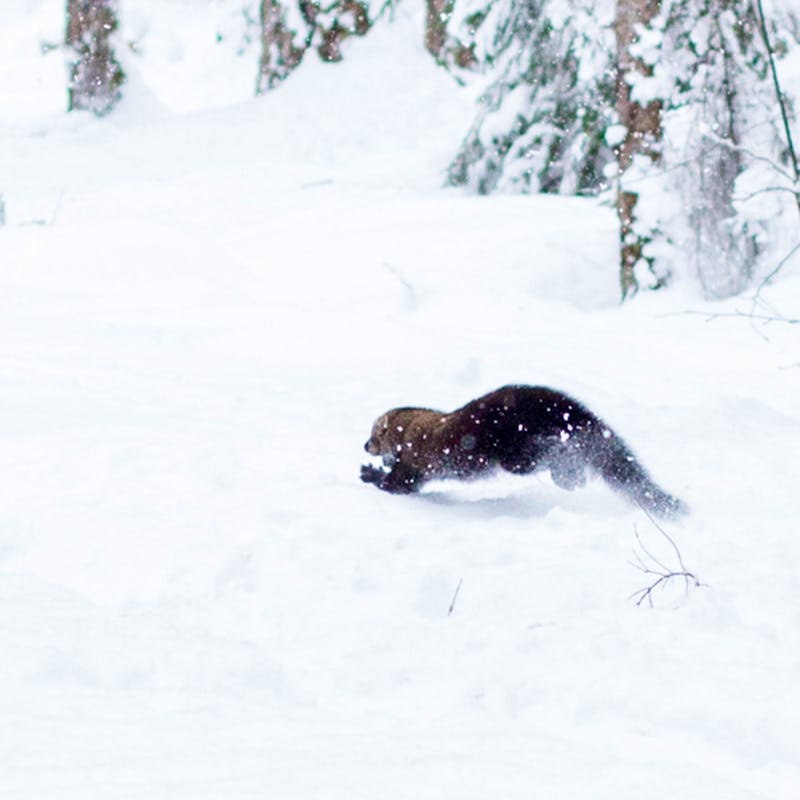Tweet“Protections and conservation strategies provided by an endangered species listing could turn the tide for fishers in the Rockies. This population can’t afford to wait any longer.”
In response to a petition from the Center for Biological Diversity and allies, the U.S. Fish and Wildlife Service announced today that the Northern Rockies fisher, a rare and vanishing species, may warrant federal protection under the Endangered Species Act. Fishers are cat-like, medium-sized members of the weasel family with slender, brown bodies and long, bushy tails. Related to minks and otters, and the only true predators of porcupines, these fishers once inhabited old-growth forests from northeastern Washington, Idaho, Montana and northwest Wyoming to north-central Utah. Trapping and loss of habitat from logging decimated the population, and Northern Rockies fishers are now found only along the border of Idaho and northern Montana. The Service will now undertake a one-year status review to determine if federal protection is warranted.
“We’re glad to see that the Service recognizes the plight of this rare carnivore,” said Andrea Santarsiere, a staff attorney with the Center. “We urge the Service to act swiftly to ensure protection for the Northern Rockies fisher before the population declines any further.”
Despite a struggling population, fishers are still legally trapped in Montana, and as trapping for wolves, bobcats and other species has been on the rise in Idaho and Montana, so have levels of “incidental” trapping of fishers. Twice as many fishers have been incidentally trapped in Idaho since 2008 as were captured from 2002 to 2007. Reported nontarget catch of fishers by individual fur-takers in Idaho from the 2010-2011 season through the 2013-2014 season have totaled 142, 62 of which have been killed. It is unknown how many fishers are incidentally trapped and killed in Montana each year because the state does not maintain records of nontarget catch.
Conservation groups originally petitioned for protection for the Northern Rockies fisher in 2009. The Service issued a negative finding on that petition, because at the time trapping levels were lower and less information was available on the specific habitat needs of the species in the northern Rockies. When new information emerged describing the threats to the species, including the increased rate of trapping in Idaho and Montana, the Center and five other conservation organizations filed another petition seeking federal protection in September 2013.
When the Service failed to respond to that petition within the year allotted by law, the groups filed a notice of intent to sue the agency; today’s finding is the Service’s first step to respond to that petition. The groups that filed the 2013 petition include the Center, Defenders of Wildlife, Friends of the Bitterroot, Friends of the Clearwater, Friends of the Wild Swan and Western Watersheds Project.
“Protections and conservation strategies provided by an endangered species listing could turn the tide for fishers in the Rockies,” said Kylie Paul, Rockies and Plains representative for Defenders of Wildlife. “This population can’t afford to wait any longer.”
“Fishers in the Clearwater region of Idaho and surrounding areas are key to the species' survival in the U.S. Rockies,” said Gary Macfarlane of Friends of the Clearwater. “Even though this critter can take on a porcupine, it is not equipped to effectively deal with threats from logging, incidental trapping and road building. This finding is a step in the right direction.”
“Fishers need protection now,” said Arlene Montgomery, program director for Friends of the Wild Swan. “Intensive surveys between 2012 and 2014 in the Southwest Crown of the Continent failed to detect any fishers, yet trapping in Montana continues to kill them and logging is degrading their habitat.”
“It’s a shame to lose any of these rare animals to incidental trapping,” said Travis Bruner, executive director of Western Watersheds Project. “But losing dozens is completely unacceptable. It’s high time that the Endangered Species Act recognize the risks the fisher is facing and for the federal government to step in and protect it.”
Defenders of Wildlife is dedicated to the protection of all native animals and plants in their natural communities. With more than 1.2 million members and activists, Defenders of Wildlife is a leading advocate for innovative solutions to safeguard our wildlife heritage for generations to come. For more information, visit www.defenders.org.
Contact:
Melanie Gade: mgade@defenders.org 202-772-0288
Kylie Paul: kpaul@defenders.org (406) 728-8800
For over 75 years, Defenders of Wildlife has remained dedicated to protecting all native animals and plants in their natural communities. With a nationwide network of nearly 2.1 million members and supporters, Defenders of Wildlife is a leading advocate for innovative solutions to safeguard our wildlife for generations to come. To learn more, please visit https://defenders.org/newsroom or follow us on X @Defenders.
Media Contact
News

Hundreds of Thousands of Americans Oppose Trump Administration Effort to Roll Back Protections for Imperiled Animals and Plant Species


